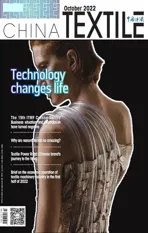Everything can be 3D printed!Custom made wardrobe in backpack
2022-11-15ByZhaoXinhua
By Zhao Xinhua

Tomorrow you’re attending a meeting in France.You decide to update your suit,so you go online and buy and download a design you like.The next day you only pack some toiletries,and fly to France.There,you use the file you brought yes—terday to print your suit and shoes.After attending the meeting,you place your suit into the hotel’s recycler where it is turned back into filament and ready for the next guest to use.
Music was once a very physical thing.You would have to go to the record shop and buy CDs,but now you can just download the music,directly to your phone.Fashion is also a very physical thing.When our clothes will be digital,just like the suit is.If 3D printed fashion continues to progress at the rate it is,then we won’t have to wait long to see if that vision becomes a reality.
While traditionally made clothing can be broken down and trans—formed into new fibers,only 0.1% of textiles collected by charities and take—back programs get recycled.In the manufacturing of new clothing,leftover scraps of material are often thrown out.Additionally,if these fashion items are 100% recyclable then they could be recon—stituted into a filament and reused once we get bored or grow out of an item.This potentially wasteless system could remove the strains of fast—fashion,and the concept of an overcrowded wardrobe.The ability for consumers to 3D print their own clothes would combat this growing environmental crisis while providing a solution to the often—expressed discrepancy be—tween typical sizes,as clothing could be customized perfectly to each individual’s fit.

TPU (thermoplastic polyurethane) is a highly flexible,durable,and smooth material.Despite being invented in 1959,it only became usable as a truly elastic 3D printing filament from 2013,in the forms of Filaflex and TPU 92A—1.TPU was required that was flexible enough to behave like conventional fabric,soft enough to be comfortable against the skin,and durable enough to be worn while completing normal activities.The most common material used for these fashion pieces is TPU,with its arrival allow—ing the industry to take its next step.
It is still unclear as to whether 3D printed fashion will play a negative role in our rising awareness of microplas—tics,as this will depend on how our understanding and use of the materials develops.Filaments can be both bio—degradable and recyclable,with PLA,currently the most commonly used filament,being a prime example.
As for footwear,3D printing is widely used by sneak—er,Nike,Adidas,New Balance,and Reebok to name a few,major brands have tried it out with varying degrees of suc—cess.One of the major interests for the technology lies in the possibilities of customization: take Adidas Futurecraft.Unlike traditional techniques,3D printing would allow Adidas to address the specific needs of each customer by printing each sole according to the foot of its customers.Inaddition,printing a 3D outsole allows you to configure its structure to maximize the performance of the final shoe:accentuate more pressurized areas and make points with low pressure more flexible.A project that has not yet reached the mass adoption stage,but prefigures a real revolution: the soles created by this method incorporate a multilayer structure that could not be developed with traditional molding techniques.
The CO&76—3D down trousers series developed by domestic enterprises adopts 3D printing technol—ogy,which has a nest—like structure between materials.The thickness of the compressed fabric is only 0.5mm.It ensures the thermal insulation effect of white goose down,and one layer can achieve three layers of thermal insulation effect of conventional trousers,making it light for winter.
Despite the current obstacles (rigidity of materi—als,environmental problems,costs and accessibility);it already offers interesting perspectives in the category of accessories,and is increasingly used in jewelry,watchmaking and of course,footwear.Optimization of production processes,customization possibilities,cost optimization (storage with on—demand printing,manu—facturing as there are no material scraps,but also for prototyping...),or creation of complex shapes...3D print—ing opens new creative fields for the fashion industry and allows to add up cutting—edge technology to tradi—tional techniques.Additive manufacturing could totally change the fashion industry,and it’s already starting to shape the future of fashion,both for Haute Couture and for ready—to—wear.
